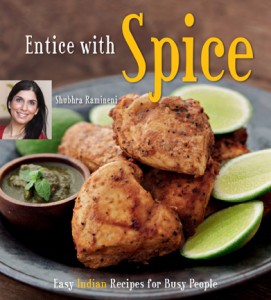Demystifying Indian Cuisine
 ENTICE WITH SPICE:
ENTICE WITH SPICE:
Easy Indian Recipes for Busy People
By Shubhra Ramineni
Tuttle Publishing
160 pp. $27.95
Like most useful things, the Indian cookbook Entice with Spice was born out of a personal need. Having grown tired of eating take-out and frozen dinners after a long day of work at the office, author Shubhra Ramineni resolved to develop simplified recipes that would allow her to cook delicious homemade Indian meals as quickly and as effortlessly as possible—all without sacrificing flavor. The result is a comprehensive collection of one hundred easy-to-make recipes from both the north and south of India. (Most recipes can be made within a half-hour or less; Chicken Biryani and Chicken Tikka Masala are exceptions, requiring about one hour from start to finish.)
In Entice with Spice, you will find a wide range of recipes, including everything from condiments, like yogurt and chutneys, to appetizers, main dishes and sides, breads and rice, and desserts and beverages. Favorite restaurant dishes familiar to Indian food lovers in America, such as Samosas, Naan, Aloo Gobi, Saag Paneer, Chicken Tikka Masala, Mulligatawny Soup, Mango Chutney, and Lassis, are included, as well as foods typically prepared in Indian homes, such as Chapati, an everyday whole-wheat flatbread cooked on a griddle; Kichidi, a simple rice and lentil porridge; Paneer Bhurji, an Indian comfort food made with crumbled paneer and green peas; and Anda Bhurji, Indian scrambled eggs. Wonderful south Indian classics like Dosa, Uttapam, and Coconut chutney, which have only recently begun to gain popularity in the United States, are also included. (Most Indian restaurants in the United States have historically served dishes from northern India.) Most of the recipes are traditional. Only a handful, such as Dad’s Baked Salmon and Masala Scallops with Tomatoes and Onions, are the author’s Indian-inspired creations.
Nearly every recipe in the book is graced with beautiful food photography by Masano Kawana, a recipient of the James Beard Award for best cookbook photography. In addition to the food photographs by Kawana, helpful step-by-step photographs are sprinkled throughout the book, as are occasional personal photographs of the author, many taken during family visits to India.
In the introductory sections of the book, the author explains the basics of Indian ingredients, equipment and key cooking terms and methods, such as curry and masala. There is even a blue print for creating a formal Indian meal. If you’re new to Indian cooking, these sections are very helpful. I suggest reading them before delving into the recipes.
DCCC members tried nearly half of the recipes in the book—forty-three in total. Compare this to the average number of recipes most home cooks make from a cookbook—just three. We shared emails about the recipes we tried during the weeks leading up to our potluck, and about where to find ingredients like whole cumin seeds and fresh curry leaves.
Standouts are Three Vegetable Raita, Chickpea Curry, Ginger Chutney, Rice with Cumin and Peas, Chicken Tikka Masala, Creamed Spinach with Cheese Cubes, and Sweet Rice Pudding. A few dishes—Chick Pea Curry, Tandoori Chicken, and Cardamom Chicken—seemed particularly fiery to members. Some dishes, on the other hand, like Chicken Tikka Masala and Aloo Gobi, we noted, are mildly spicy. In general, dishes from southern India will be hotter than those from northern India.
If you don’t like a lot of chili heat, you can easily adjust the amount by using less cayenne, less fresh or dried chili peppers, and/or deseeding chili peppers. Keep in mind, too, when tasting dishes for chili level, that nearly every bite of Indian food is eaten with bread or rice and a cooling condiment such as plain yogurt or Raita, all of which serve to balance chili heat. The same goes when tasting Indian food for seasoning. Remember that the breads, rice, and cooling condiments eaten with Indian food have no salt or very little.
Cooking from Entice with Spice was the first time DCCC members had cooked Indian food in a focused and dedicated way. We appreciated the accessible nature of the book and think it’s ideal for anyone new to cooking Indian food. Some members had previously attempted to cook Indian food at home using cookbooks with more time-consuming and complex recipes, and had been put off to Indian cooking in the process. We all feel Entice with Spice is a great book to become comfortable and familiar with Indian cooking. And, as a testament to the tastiness of the food, and general ease of which it can be made, I think everyone is likely to cook from it again.
